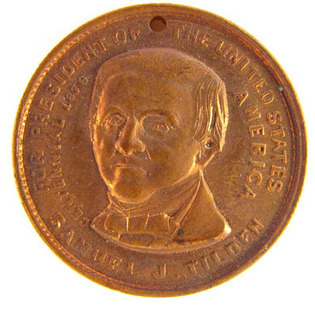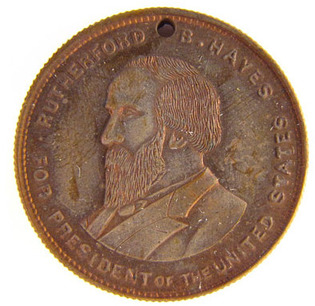 loading
loading
Old YaleAnother almost-presidentThe secret Compromise of 1877. Judith Ann Schiff is chief research archivist at the Yale University Library.  Manuscripts and ArchivesView full image Manuscripts and ArchivesCampaign medals for the 1876 presidential election featured Yale alumnus Samuel Tilden, Class of 1837, ’75LLD (top), and his opponent, Rutherford B. Hayes—whose win was arranged in a political bargain after a disputed election. View full imageOne hundred and forty years ago, a highly accomplished attorney, Democrat, and Yale graduate ran for president, won the popular vote, and lost the Electoral College. But the 1877 defeat of Samuel J. Tilden, Class of 1837, ’75LLD, was in a class by itself. Tilden was born in a small town near Hudson, New York, in 1814 to a family with connections. His farmer-merchant father was a friend of future president Martin Van Buren, and young Samuel enjoyed their political conversations. Just before entering Yale, he wrote a Democratic Party manifesto that was used in the state campaign. Tilden’s college career was short: he was studious, but ill health forced him to drop out in his sophomore year. Still, he was considered a fellow alumnus by his Yale classmates, and in 1875, he would receive from Yale both an honorary LLD and an 1837 BA. He studied law at New York University and passed the bar exam, though he never earned a degree. Through the 1840s and ’50s, he became a leading corporate lawyer, working for most of the developing railroad companies of the Northeast. He became politically active on the state level, starting in the State Assembly. During the Civil War, he joined most northern anti-slavery Democrats in supporting Lincoln and the war to restore the Union; and in opposing Republican attempts to increase the power of the central government and punish the South. After 1870, he joined in a vigorous and successful campaign against the corrupt Tweed Ring that controlled New York City. Tilden became the recognized leader of the New York Democratic Party. In 1874 he was elected governor. He became nationally known as a reformer who emphasized efficiency and economy, and in 1876 the Democratic National Convention in St. Louis nominated him for the presidency. His opponent was Republican Rutherford B. Hayes. Tilden won the popular vote, 4,284,265 to 4,033,295. But on November 11, 1876, it was reported that he had just 184 electoral votes—one short of a majority. Hayes had 166. A total of 19 electoral votes in Florida, Louisiana, and South Carolina had been declared fraudulent. Then one of the Oregon electors was disqualified, reducing Hayes’s total to 165 and raising the number of disputed votes to 20. What followed was a debacle. Each party in the three disputed southern states declared that its own candidate had won. Consequently, each state submitted two sets of electoral ballots—one favoring Tilden, the other Hayes. No procedure in the Constitution existed to settle the problem. Finally, Congress appointed an Electoral Commission, with representatives from both parties, to forge a solution. The meeting of the commission in February was kept secret. But according to tradition, the two sides worked out a political bargain, now known as the Compromise of 1877. The Democrats in the South pledged to switch their support to Hayes. In return, the Republicans agreed to drop their military support of the last Republican governments in the southern states—leaving the Democrats in control throughout the South and leaving freedmen in the region without protection. The great Yale historian C. Vann Woodward would write that the compromise “laid the political foundation for reunion.” Congress accepted the commission’s findings on March 2. Two days before the presidential inauguration of March 5, 1877, Republican Rutherford B. Hayes was elected president. Some called it the “Fraud of the Century.” Tilden, widely known for his dignity and good nature, remarked upon losing the election: “I can retire to private life with the consciousness that I shall receive from posterity the credit of having been elected to the highest position in the gift of the people without any of the cares and responsibilities of the office.” In 1880, and again in 1884, he declined the Democrats’ offer to run for the presidency, and he spent his later years quietly. He died in 1886. A bachelor and devoted reader, he left most of his estate to “establish and maintain a free library and reading room in the city of New York.” The Yale Class of 1837 boasted a secretary of state and a chief justice of the Supreme Court. It very nearly had a president as well. With a shift of just one electoral vote, Tilden would have been Yale’s highest-ranking statesman—and, when the residential colleges were named in 1931, he would have bested John C. Calhoun, Class of 1804. Today, his only memorial at Yale is the Tilden Entry in Saybrook Court of Saybrook College, which is inscribed with his name.
|
|
3 comments
-

Richard J McManus YC'67, 4:08pm March 05 2017 |  Flag as inappropriate
Flag as inappropriate
-

Mark Branch, 6:25pm March 05 2017 |  Flag as inappropriate
Flag as inappropriate
-

Barnet Schecter YC'85, 10:07am March 16 2017 |  Flag as inappropriate
Flag as inappropriate
The comment period has expired.A question for Judith Schiff: At a Yale Alumni College course in Princeton last year we had a disagreement last year about the number of Confederate alumni on the wall in Woolsey Hall. To my memory, it was very few, perhaps a handful. Others said there was quite a number. My memory may be prejudiced, since my immigrant ancestor, Timothy McManus, was surgeon in a Union Regiment who died of cholera in Grant's Vicksburg campaign. I can't seem to find the answer online. I remember the names on the wall as overwhelmingly blue, not gray. Dick McManus
Mr. McManus: There are 114 Union dead and 54 Confederate dead listed on the memorial. This article from our Sep/Oct 2011 issue has more about how the memorial came about: https://yalealumnimagazine.com/articles/3279
Yale is better off without a Tilden College. Tilden's strategy for the Democrats after the Civil War was "condemnation and reversal of negro suffrage.” In the election of 1876, Tilden’s victories in the South were fueled by Klan violence and intimidation that kept black and white Republicans away from the polls. Had Tilden become president, the result for African Americans would have been the same: The withdrawal of federal troops from the former Confederacy and the demise of Reconstruction, the Republican program of freedom and equality for blacks that was born with Abraham Lincoln’s Emancipation Proclamation and died with the Compromise of 1877. The end of Reconstruction brought nearly a century of Jim Crow rule in the South. Today, with renewed efforts to suppress minority votes, the history of Reconstruction is vitally important.